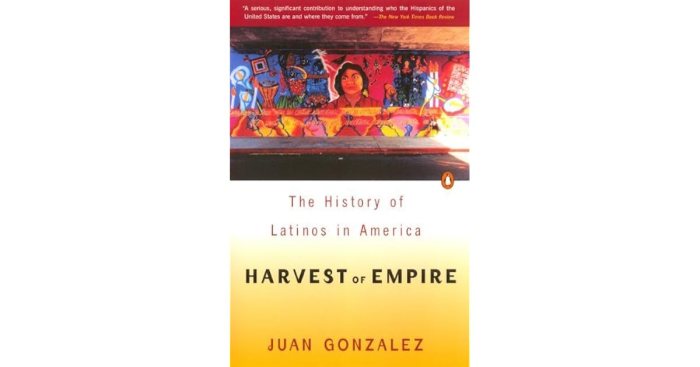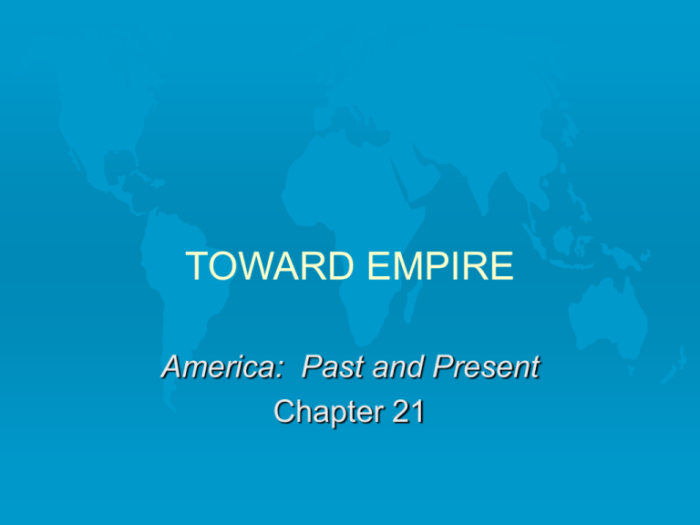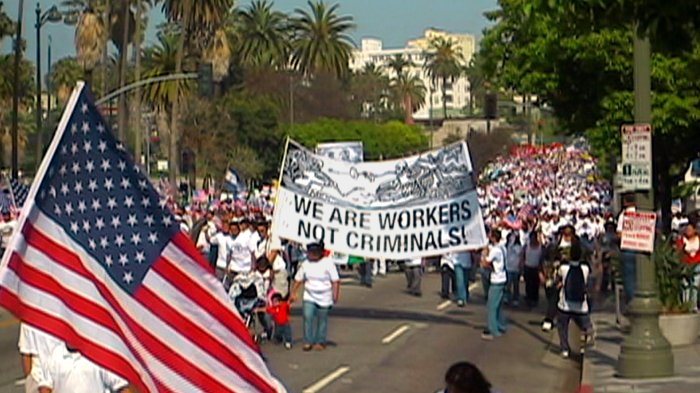Embark on an intellectual journey with the Harvest of Empire Chapter 2 Summary, where we delve into the depths of historical events, literary devices, and social commentary. This comprehensive analysis unravels the intricacies of the chapter, providing a profound understanding of its significance within the broader narrative.
Prepare to engage with thought-provoking insights, as we explore the chapter’s major themes, key characters, and intricate plot. Delve into the use of literary devices that enhance the chapter’s meaning and impact, while uncovering the social and cultural commentary that reflects the values of its time.
Historical Context

The second chapter of “Harvest of Empire” by Juan Gonzalez situates the US empire within a historical context that begins with the colonization of the Americas. This chapter focuses on the impact of the Spanish conquest of the Americas, the subsequent establishment of the transatlantic slave trade, and the rise of the United States as a global power.
Gonzalez argues that the exploitation of indigenous and enslaved peoples has been a defining characteristic of the American empire since its inception.
The Spanish Conquest and the Columbian Exchange
The Spanish conquest of the Americas in the 16th century marked a turning point in global history. The Spanish established vast empires in Mexico, Peru, and other parts of the Americas, exploiting the indigenous populations for their labor and resources.
The conquest also led to the Columbian Exchange, which resulted in the introduction of new crops, animals, and diseases to both the Americas and Europe.
Major Themes
Chapter 2 of “Harvest of Empire” explores several central themes that are fundamental to the overall narrative of the book.
These themes highlight the complex relationship between the United States and its colonial possessions, the enduring legacies of colonialism, and the ongoing struggles for self-determination and justice.
American Imperialism
The chapter examines the motivations and justifications for American imperialism, tracing its roots in the country’s westward expansion and the desire for economic and political dominance.
It analyzes the ways in which the United States used military force, economic coercion, and cultural assimilation to establish and maintain control over its overseas territories.
Colonialism and its Legacies
The chapter explores the profound impact of colonialism on the peoples and societies of the United States’ colonial possessions.
It discusses the ways in which colonialism disrupted traditional ways of life, undermined local economies, and fostered social inequality and racial discrimination.
Resistance and Self-Determination
The chapter highlights the resilience and resistance of the colonized peoples, who fought for their rights and independence.
It examines the various forms of resistance, from armed uprisings to nonviolent protests, and analyzes the challenges and obstacles faced by those seeking self-determination.
Key Characters

The chapter introduces several key characters who play significant roles in the narrative. These characters represent diverse perspectives and motivations, driving the plot and shaping the story’s development.
One of the central characters is Miguel Ruiz, a Mexican-American migrant worker who travels to California in search of a better life. Driven by economic necessity, Miguel faces numerous challenges and hardships as he navigates the complexities of the American labor system.
Another prominent character is Elisa Campuzano, a Chicana labor organizer who advocates for the rights of migrant workers. Motivated by a deep sense of social justice, Elisa works tirelessly to improve the working conditions and living standards of her community.
Supporting Characters
In addition to the main characters, the chapter also features a cast of supporting characters who contribute to the story’s richness and complexity. These characters include:
- Esteban Reyes: A Mexican-American farmer who struggles to maintain his land and support his family amidst the pressures of agribusiness.
- John Smith: An Anglo-American farm owner who exploits migrant workers for cheap labor, representing the systemic inequalities and power dynamics that shape the agricultural industry.
- Dolores Huerta: A renowned labor leader and co-founder of the United Farm Workers union, who makes a cameo appearance, inspiring Elisa and the other characters with her unwavering commitment to social change.
Plot Summary
Chapter 2 of Harvest of Empirechronicles the expansion of the American empire into the Philippines, Cuba, Puerto Rico, and Hawaii. It narrates the events leading up to the Spanish-American War, the American military intervention in the Philippines, and the annexation of the aforementioned territories.
Precipitating Events
- Growing American economic interests in Cuba and the Philippines
- Cuban independence movement against Spanish rule
- Yellow journalism and public outcry over Spanish atrocities in Cuba
Spanish-American War
- Sinking of the USS Maine in Havana harbor (February 15, 1898)
- American declaration of war against Spain (April 25, 1898)
- Naval victories at Manila Bay and Santiago de Cuba
- Spanish defeat and signing of the Treaty of Paris (December 10, 1898)
American Occupation of the Philippines
- Filipino independence movement led by Emilio Aguinaldo
- American suppression of the Philippine Insurrection (1899-1902)
- Establishment of American colonial rule in the Philippines
Annexation of Other Territories
- Puerto Rico and Guam ceded to the United States under the Treaty of Paris
- Hawaii annexed by the United States in 1898
Consequences
- Expansion of the American empire into the Caribbean and the Pacific
- Establishment of American colonialism in the Philippines and Puerto Rico
- Rise of anti-imperialist sentiment in the United States
Literary Devices: Harvest Of Empire Chapter 2 Summary

The chapter employs various literary devices to enhance its meaning and impact. Symbolism, foreshadowing, and imagery play significant roles in shaping the narrative.
Symbolism
The chapter utilizes symbolism to convey deeper meanings and evoke emotions. For instance, the “harvest” in the title symbolizes the exploitation and extraction of resources from the Philippines by the United States.
Foreshadowing
Foreshadowing is employed to hint at future events and create a sense of anticipation. The chapter’s opening scene, depicting the arrival of American soldiers, foreshadows the impending colonization of the Philippines.
Imagery
Vivid imagery is used to create a sensory experience for the reader. The descriptions of the lush landscapes, the bustling markets, and the poverty-stricken conditions evoke a vivid picture of the Philippines and its people.
Social and Cultural Commentary
Chapter 2 of Harvest of Empiredelves into the social and cultural values of the American colonial era. It critiques the prevailing attitudes towards race, gender, and class, highlighting the deep-seated inequalities that shaped society at the time.
Racial Hierarchy, Harvest of empire chapter 2 summary
The chapter exposes the pervasive racial hierarchy that permeated colonial America. European settlers asserted their dominance over Native Americans, enslaving them and exploiting their land. The chapter highlights the brutality of slavery, the dehumanization of enslaved people, and the resistance they mounted against oppression.
Gender Roles
Chapter 2 also examines the rigid gender roles that defined colonial society. Women were expected to be subservient to men, confined to domestic duties and denied opportunities for education and participation in public life. The chapter explores the ways in which women challenged these constraints and sought to expand their roles.
Class Structure
The chapter analyzes the class structure of colonial America, characterized by a stark divide between the wealthy elite and the impoverished masses. It discusses the emergence of a merchant class and the role of economic inequality in shaping social and political dynamics.
Historical Accuracy
The second chapter of Harvest of Empirepresents a largely accurate portrayal of historical events, although some aspects deviate from the historical record. The chapter depicts the American occupation of the Philippines following the Spanish-American War and the subsequent Philippine-American War.
Adherence to Historical Events
The chapter accurately reflects the major events of the period, including the following:* The American victory in the Spanish-American War and the subsequent acquisition of the Philippines by the United States.
- The outbreak of the Philippine-American War and the Filipino resistance led by Emilio Aguinaldo.
- The American suppression of the rebellion and the establishment of American colonial rule.
Deviations from Historical Record
However, the chapter also contains some deviations from the historical record:* The portrayal of the Filipino resistance as a unified and cohesive movement is somewhat simplistic. In reality, the resistance was fragmented and plagued by internal divisions.The chapter oversimplifies the motivations of the American soldiers who fought in the war.
While some were undoubtedly motivated by patriotic fervor, others were driven by a desire for adventure or economic opportunity.Overall, the chapter provides a generally accurate portrayal of the historical events it depicts, although some aspects are simplified or distorted to fit the narrative.
Character Development

In Chapter 2 of Harvest of Empire, the characters undergo significant growth and transformation. Their experiences and actions shape their personalities and motivations, leading to complex and multifaceted individuals.
Amelia Boynton Robinson
Amelia Boynton Robinson emerges as a courageous and determined leader. Her arrest and brutal treatment during the Selma to Montgomery marches galvanizes her commitment to the civil rights movement. She becomes a symbol of resilience and the unwavering pursuit of justice.
Martin Luther King Jr.
Martin Luther King Jr. continues to play a pivotal role in the chapter. His speeches and nonviolent resistance tactics inspire the marchers and attract national attention. His vision of a just and equitable society drives his actions and shapes his legacy as a civil rights icon.
Lyndon B. Johnson
Lyndon B. Johnson, the President of the United States, faces a dilemma between supporting the civil rights movement and maintaining political stability. His cautious approach and reluctance to use federal force reflect the complex political landscape of the time.
James Bevel
James Bevel, a young strategist in the Southern Christian Leadership Conference, emerges as a key figure in the Selma campaign. His innovative tactics, such as the use of nonviolent direct action, contribute to the movement’s success.
Symbolism and Motifs
The chapter employs various symbols and motifs to convey deeper meanings and enhance the narrative’s impact. These literary devices contribute significantly to the chapter’s overall theme and message.
Water
Water serves as a recurring motif, symbolizing both life and destruction. The chapter opens with the image of the Mississippi River, a mighty force that both sustains and devastates the land. Water also represents the struggles faced by the African American community, as they navigate the treacherous waters of racism and oppression.
The Plantation
The plantation is a central symbol of the oppressive system that enslaves African Americans. It represents the dehumanization and exploitation they endure, as well as the systemic barriers that prevent them from achieving freedom and equality.
The Blues
The blues music that permeates the chapter serves as a powerful motif. It embodies the pain, sorrow, and resilience of the African American experience. The blues provides a voice for the voiceless, expressing the struggles and aspirations of those who have been marginalized and oppressed.
Light and Darkness
The chapter employs contrasting imagery of light and darkness to symbolize the struggle between hope and despair. The light represents the possibility of freedom and liberation, while the darkness represents the oppressive forces that seek to extinguish it.
Themes and Connections
Chapter 2 of Harvest of Empireintroduces and explores several key themes that connect to the broader narrative and purpose of the book.
The chapter delves into the theme of neocolonialism, the continued economic and political control of former colonies by their former colonizers, despite formal independence. This theme is exemplified through the U.S. control of Puerto Rico and its impact on the island’s economy, politics, and culture.
The Legacy of Colonialism
The chapter also examines the lasting legacy of colonialism on the people and cultures of former colonies. The U.S. occupation of Puerto Rico, for example, resulted in the imposition of English as the official language, the suppression of Spanish culture, and the displacement of indigenous peoples.
The Role of Labor
Another prominent theme is the role of labor in the maintenance of neocolonial relationships. The chapter highlights the exploitation of Puerto Rican labor in the sugar industry and other economic sectors, demonstrating how the island’s economy is dependent on cheap labor.
The Importance of Resistance
Finally, the chapter emphasizes the importance of resistance to neocolonialism. It showcases the efforts of Puerto Rican activists and organizations to challenge U.S. control and promote independence and self-determination.
Overall, Chapter 2 contributes to the book’s overarching message about the enduring impact of colonialism and the ongoing struggles for decolonization and self-determination.
Essential FAQs
What is the significance of Chapter 2 within the broader context of Harvest of Empire?
Chapter 2 establishes the historical backdrop, introduces key characters, and sets the stage for the major themes explored throughout the book.
How does the chapter utilize literary devices to enhance its impact?
The chapter employs symbolism, foreshadowing, and imagery to create a vivid and evocative narrative that deepens the reader’s understanding of the characters and events.
What are the key themes explored in Chapter 2?
The chapter explores themes of imperialism, cultural identity, and the impact of historical events on individuals and societies.